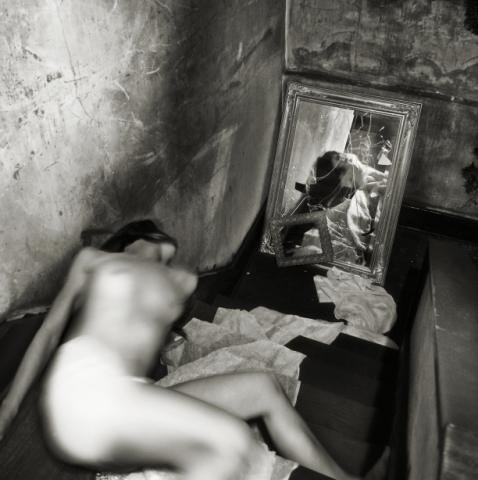I’d never written a story to a photo before a friend and I swapped photos for a 100-word story exercise a couple years ago. She gave me a photo by Francesca Woodman. I didn’t know who Francesca Woodman was. The photo was about as arresting and disturbing as a photo can be: a beautiful nude woman, blurry and abandoned, sprawled upside down on a stairway that has a cracked mirror at the bottom.
My story was very literally titled “Model Upside Down on the Stairs.” The photo overwhelmed the story, of course, although I managed to recently publish it in PANK, which just published an interview with me about the story as well.
The model in the photo is elegant and poised, yet doomed and falling, and contorted in a way that begs the question of what has happened to her, how has she lost herself. It’s a photo that demanded a story, simply because of its irreconcilable contradictions, which was why I was surprised when I went to the Francesca Woodman exhibit at SF MOMA last December and read on a placard that Woodman wasn’t a narrative photographer.
I jotted down my rebuttal to that notion as I studied her haunting excavations of self. She took most of her photos in a rundown apartment house while at the Rhode Island School of Design, posing nude with broken mirrors and crumbling walls in a style reminiscent of 19th century spirit photography, her photos playful but taunting, erotic but not quite erotic, a self blurred but wanting to be seen. Unfortunately, I lost that notebook, but my conclusion was that her photos told a quite courageous and troubling narrative. She’s the type of artist brave enough to empty her innards yet remain inscrutable at the same time.
She killed herself at the age of 22 in 1981. A friend of mine posited that she was sexually abused. Many photos certainly hint at that, perhaps especially the one of the black, muddy handprints on her breasts and her crotch. And then there is a series called “Charlie the Model,” one of few that includes a man. In one picture he kneels naked next to a mirror while Woodman stands, also nude, behind him. She is blurred, as if she's violently recoiling from him, affronted and afraid of his sexuality.
Some photos appear innocent by contrast, however. She revels in the play of self, embracing the angelic and the demonic, the naïf and the seductress. I’ve read critics who disparage her work as sentimental and melodramatic, but that’s part of the reason I like it; her photos possess the daring verve of youth, the ability to scream while not wanting anyone to respond. In fact, her family and professors didn’t know about the wide body of her work until after she’d died.
The question with photographers like Woodman is how much they truly want to be known, how much they even want to know themselves. In so many photos her body blurs into a wall. She wants to appear even as she disappears. Dematerialization is one of her themes. It seems as if she’s exploring the poses one has to travel through to discover or create the final pose of self, as if there is a final pose, but she's dodging herself all the time, even in her states of nakedness, making sure no one can truly know her.
Thank God for the Francesca Woodmans of the world, although I wish she would have lived longer, discovered the restful state that sometimes can only come with age, and come out from her wispy smudges of self to be seen. Her fervency would have surely faded, but perhaps she would have slowed down, finally told her story. Inscrutability comes with a price, and screams usually want to be heard.
Subscribe to:
Post Comments (Atom)





No comments:
Post a Comment